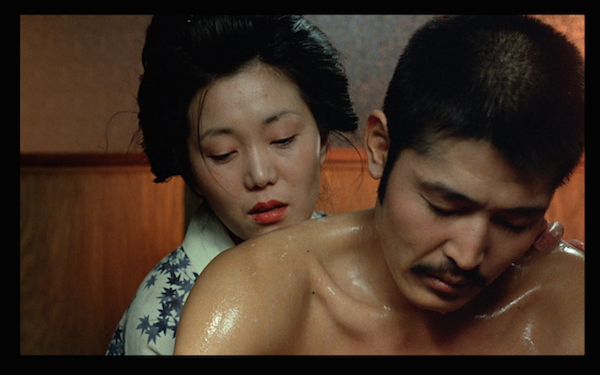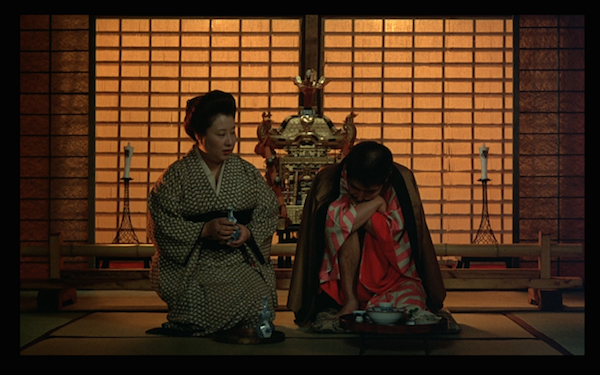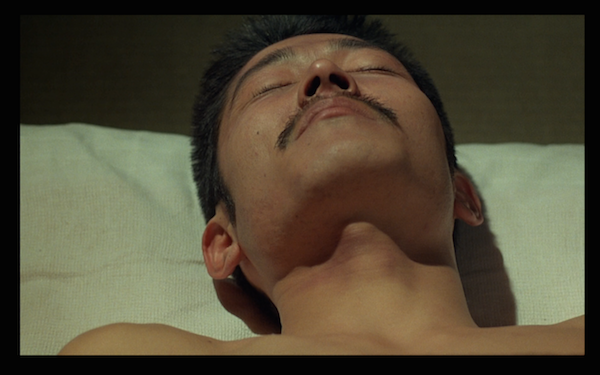Blog Archives
In the Realm of the Senses, Nagisa Oshima, 1976

In the Realm of the Senses is shocking, vile, gruesome and absurd, all of which were intentional. It meant to provoke us (and Japan) away from our mundane social norms, like a lot of 1970s filmmakers were doing across the globe. With the Japanese fierce censorship code, this film is even more shocking, and it reveals something about their moral code given that it still has not been shown in its uncut entirety today.
However disturbing, it is essentially a film about love. To most people, including myself, this type of love would be revolting and unfathomable. The woman has an unquenchable sexual thirst, while the man serves as a vehicle for her insatiable desire. As their relationship progresses, the ordinary becomes boring and she continues to ratchet up their activities. This makes for a more controversial and shocking film as it goes along, but it is fitting in how the plot develops and resolves.
When I first watched it, I found it shocking and amusing. That was also intended. Scenes such as when children throw snowballs at an older man’s genitalia add very little to the plot, and serve only to further provoke. The older man in question is only pertinent because he recognizes Sada, the lead character, as a former prostitute, although that could have been handled differently.
The sexual acts get more amusing, whereas the climax (no pun intended) and resolution are outlandish and way over the top. I was surprised to learn later that this was a true story. This one needed some time to settle and appreciate, and thanks to a good number of Criterion supplements, I received plenty of context and analysis.
Even though the description of the film would sound like pornography (and in a way, it is), the difference is that this was created and produced by professionals and has an artistry that lessens the stimulation. The set designs and photography are gorgeous, and even though the characters are doing unsettling things with their bodies, they are framed by an auteur. One such example is during the wedding scene. The man who had previously conducted the ceremony is doing some sort of celebratory dance. The camera pans upward so that he and his dance are the focus of the shot. It settles there for a time as he continues dancing, and then pans down to his feet where an orgy is taking place among the entire wedding party. Again, it is meant to shock and not titillate.
From here on out, I have to discuss the ending. Please stop reading here if you are spoiler averse.
As domestic, routine sexual activity becomes boring, Sada veers into sado-masochism territory. This is introduced through her earning her living as a prostitute, and encouraging her client to slap her repeatedly. She enjoys this so much that she brings it into her own bedroom. This leads even further, and she eventually gets fixated on choking. She likes the sensation when he is being choked during the sexual act. Even this eventually becomes mundane, and they have to go even further.
To understand Kichi’s behavior and final sacrifice, you have to understand a little bit about Japanese culture. They have a certain fascination with it, and they think of it as courageous to sacrifice one’s life for another. The most obvious examples of this ideology are the kamikazes in World War II. We also decorate our heroes, but in Japan it is different. It is truly honorable to die by one’s own desire.
When Kichi tells Sada that next time she should not stop with the choking, he is committing his final sacrifice. This is him letting go, giving everything he has in order to please who he loves, because there is nothing else within him that can satisfy her any longer. From a Japanese perspective, it is an honorable, if unconventional, way to die.
The ending is foreshadowed throughout the film. She has been characterized to have a violent streak, and had even threatened to cut off his manhood earlier in the film. There are scenes where she uses sharp objects, such as the time she holds a knife in her mouth, or the fantasy she has of cutting up Kichi’s ex-wife. Once she realizes that Kichi is gone, she simply takes what she feels belongs to her, his manhood. Again, this is shocking and grotesque, but in the context of their relationship, it is another act of love. She is taking her favorite part of his, and what’s left is her intense loneliness.
Film Rating: 8/10
Supplements:
Commentary: – This was a fantastic commentary from film scholar Tony Rayns, which was not expected. He begins by disclaiming that he will not be commenting on the sexual acts themselves, and he takes an academic approach to the film that was enlightening and refreshing.
He reveals that the popularity of artistic sex films in America prompted the project to start. Japanese had many sex films, but that’s not what they were going for. This was a true story, and the filmed version a lot more similar to the reveal events. Not every scene was true, of course, but the broad strokes of the plot were real.
They were a working class couple, not very educated, and they continue an erotic tradition that goes back centuries until Edo period. It stopped around Meiji period, where outside morals infringed on them. Because of this, In the Realm of the Senses is in part a political film, but that is difficult for Americans to tell unless they have a good sense of Japanese history.
Oshima drew on the trial transcript and the Sada story that was told after she was released from jail and published later. Oshima had made other provocative films, but this was his first from the female perspective. Of course it would not have made much sense to tell this story from a male point of view..
The sexual pleasure on film is all from Sada, and not from Kichi. He is never shown or heard actually in an orgasmic state. Even in the scene where his pleasure is shown in physical form, he does not moan or shudder. It is shown from her perspective and she takes the pleasure in his discharge, not him.
The true story is that after Kichi dies, the story becomes popular and people side with Sada. That is strange given what we’ve seen on film, but it is not too abnormal given Japanese culture. He gave his life for her.
Interviews:
Oshima and His Actors – This was a 1976 interview with the lead actors and Oshima for Belgian TV in 1976. Fuji does not actually speak in this interview, and Oshima does the majority of the talking, He says this was the first hard-core pornographic film in Japan. The other ‘pink’ films, as he calls them, were tame in comparison.
Eiko Matsuda, who plays Sada, speaks briefly and seems uncomfortable. She had an inferiority complex when she heard about the film. It helped her work through it, and so she feels it was her destiny.
Tatsuya Fuji – The lead actor was interviewed for Criterion in 2008.
French title was “Empire of the Senses” which is a better fit. He felt that his relationship was very much a dual, two-person empire, and their desires are their own. They should not be judged.
He said not many actresses could have taken such a role, not just because of the ability, but also the courage. Eiko had worked in underground theater and had a different perspective than most actresses.
Oshima created a relaxed and gentle atmosphere on set. He was very polite and let the actors be. Usually the set would be cleared for the sex scenes with just the actors and Oshima present.
He talks about how the sense of dying in Japan is different. They see life as a “a fleeting dream.”
Recalling the Dream – Even though this segment is under the Interview category, it is more of a documentary. It is a 40-minute segment that talks with a number of people who were involved with the film from behind the camera.
French distributor Dauman had imported Oshima’s Death by Hanging. He then moved from distribution to production, and it was Dauman that wanted an erotic film. Oshima was a leftist and it was thought that he would use sexual imagery as a political statement, but it turned out to be a conventional love story, albeit with political overtones.
They got around French legalities because they were technically French sets. All the film and negatives went to France. It was not developed in Japan during or after filming. It had been developed in Japan, the lab would be charged with indecency. It was unusual for the crew to not see dailies or any footage during the shoot. They just had to trust that Oshima was getting what he needed.
When the filmmakers and crew returned from France after the initial release, customs and police waiting for them. They had to screen the print to customs because it was a customs bond, which was the only time the film was ever screened uncensored in Japan. It was an audience of 50 people. For the Japanese release, they put a black bar on the entire lower part of the frame to censor the sexual activities.
Police wanted to go after Oshima for something and couldn’t. Instead they went after the script. The result was that Oshima apologized for stimulating the judge, police and authorities in the hearing. It sounds today like he was being sarcastic, but that was actually part of the deal.
Censorship is more liberal in Japan now, but they still cannot show the uncensored film. The biggest victory was being able to show the castrated penis uncensored.
Deleted Footage – Most of the scenes were simply extensions of existing scenes and were not too necessary. For instance, they extend a scene with her playing music at the inn to hide that they are having sex. The most notable deleted footage was that of the non-fatal choking scene and just after Kichi’s death. That scene is extended with Sada acting frantically and looking around, presumably to make sure nobody was around. They probably shortened that scene to make it seem more like love and less like a crime.
Criterion Rating: 8.5/10





